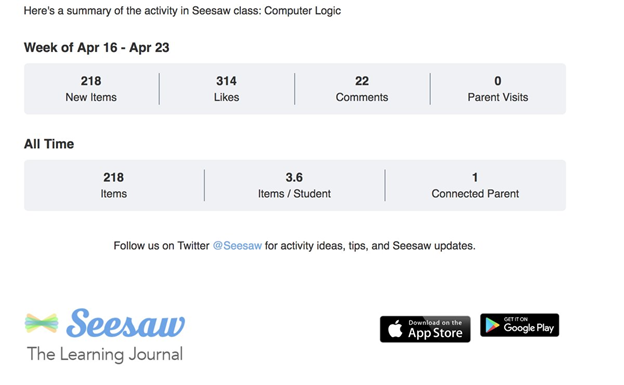Event Report – Logic Is Fun (4/22 @ Mercer Island Community Center)

These numbers summarize the engagement during the class and the power of social learning we did on April 22. The class “Computer Logic” was held in Mercer Island Community Center. We livestreamed via Youtube to Fukuoka (Japan) and Kumamoto (Japan).

Kumamoto

Fukuoka
We (Seattle IT Japanese Professionals) have been using Seesaw for our Computer Science (CS) class as it is easy to use and helps students engage in the class using a tablet or a computer. We believe that this is the class format we should be aiming for.
We conducted our class in English, even though it was livestreamed to kids in Japan. We believe that learning CS in Japanese has its limitations and is not the most optimal. We hope CS educators in Japan will come to share our view.
Before the class, we asked students to upload a self-introduction video to Seesaw in English or Japanese. The students created many interesting videos however, we are not able to show it here due to privacy concerns.
Our class started off using Google Home to showcase how computer logic is implemented into our interactions with computers. We used the “Mystery Animal Question” quiz to engage the students. One of the students in the class volunteered to ask Google Home a series of questions. We found that there still may be difficulties for students to talk to Google Home depending on their age.

Seattle
The quiz can be represented by decision tree like the following:

A decision tree in Mystery animal game.
This is an example of computer logic and Google Home and is powered by machine learning and AI.
Next, we learned what computer logic is. Using questions in the Mystery Animal Questions, we introduced the concept of statements and their results (True or False). Examples we used were “The earth is round” (True) and “Tokyo is in USA” (False).
- The words belong to True are: 1, Yes, right and はい.
- The words belong to False are: 0, No, wrong and いいえ
After that, we introduced four personified characters each relating to computer logic.

- Mr. FOLLOW: always do the same
- Mr. NOT: always do the opposite
- Mr. AND: greedy
- Mr. OR: relax
Using these characters, we started playing a logic game. Once the students were accustomed to the rules, we had them record it on Seesaw. Based on a particular Seesaw Activity, the Seattle students produced a video and the Japanese students also produced a video.
Seattle student’s video
Japanese student’s video
After the students posted their activity on Seesaw we introduced truth tables.

Seattle
Here we created an AND truth table using the question “Are you a Japanese AND a baseball player?” for Tom Cruise, Kenji Imasaki, Felix Hernandez, and Ichiro Suzuki.
We created similar truth tables on Seesaw activities for the students to fill them out on their own.
Of course, our SIJP CS class does not end without the Kahoot quiz show.

Seattle

Fukuoka

Kumamoto
Take a look at the slides for the class.You can try our quiz as well.
After the class, as reward for working hard, we had delicious pizza.

Seattle
Feedback we got:
- The early part of the class focused on the algorithms (and,or) coders need to know for programming. A few students near me mentioned they didn’t understand how the hand exercises were related to programming. While I thought the content of the whole class was good, it might help the students if there is more explanation of how the hand exercise relates to coding. This is just a suggestion, otherwise I thought it was a great class. Thank you all so much for hosting the class!

Japanese parents’ satisfaction.

Japanese and Seattle students satisfaction.
We think the main reasons for comparative lower score is mainly due to
- Japanese kids had difficulty in understanding English
- Livestreaming caused some AV issues.
We will try try to resolve these issues in the next class.
日本語でのフィードバック
保護者の皆様から、良かった点として次のようなフィードバックをいただきました。
- Binaryをゲーム感覚で掴めた点
- 最先端技術の分野で働く方の話が聞けた点
- ゲームだったので、英語のわからない息子も楽しめた
- 基礎が学べた
- 英語でロジックを説明いただいたこと、質問タイム
- 英語に触れ合えた。プログラミングの基礎を知ることができた
- 内容がクリアでよかった
- 英語の必要性を改めて感じた。この様な機会はめったにないのでいい刺激になってくれると良い
- オンラインで各地域とつながったこと
- コンピュータの仕組みが勉強になった
- はじめての参加だったが、「難しかったけど、楽しかった。」と子供たちが言っていた点
- わからないところもスタッフの方が教えてくれていたところ
- 最初に自己紹介の動画の宿題にが出ていたのが良かった。seesawに少し慣れる事が出来き、友達に親近感を持ってイベントに参加出来た。
- 絵や例を使った説明がわかりやすかった
- 日本と同時進行だったため、同じように学ぶ子供達がいることが、シアトルで参加した子ども達にも分かって良かった。また、IT企業で働かれている方達の話も興味深かった。
保護者の皆様からの改善点として、次のようなものがあげられました。
- ネット接続 が難しい
- シアトルの映像が少し不明瞭だったのと、言葉が聞き取りづらかった
- 初心者へのフォロー
- 音が聞こえにくかった
- 映像が見にくいい場所だったので、もう少し見やすいと子供の興味をひきつけてくれてよい
- マイクの声がこもって聞こえづらかった。
- 年齢的に子供が早すぎたかもしれない。野心的な試みと思うだけに、こちらの準備が出来ていないことが残念。
- 子供達には難しい言葉や説明があった
- 最初、繋がるまでが少し時間がかかった
- ボランティアの方々の役割分担がもっとはっきりしてると段取りよく進むかなと思う
- 英語の理解が早いシアトルの子ども達には、やや退屈だったかもしれない。私の息子(小6)は楽しかったといっていたが、中学生以上の子供は、やや退屈そうにしていた。
子ども達の思う良かった点は次のようなものがあげられました。
- ぜんぶ
- ゲームを取り入れたこと
- 英語が学べた
- いろいろな仕事があることが分かった
- 少しわかりました
- 色んなことがあることを、しりました
- ロジックゲームが楽しかった
- 英語で学習できたこと
- ゲーム感覚できてよかった
- 0と1の理解をゲームで教えることができるとわかったこと
- TrueTableが楽しかった
- シーソーゲームが楽しかった
- シアトルと福岡と一緒に勉強したこと
- 楽しかった
- 普段学校などでは教えてくれないことを学べたのでよかった
- たのしくまなべた
子ども達からあげられた改善点は次のようなものがありました。
- ない
- 先生の声がこもって聞こえなかった
- 内容的に年齢が早かったかもしれない
- もう少しゆっくり進めて欲しかった
- もっとわかりやすくやってほしかった
- マイクの音声が聞こえてこない時があった
- 画質をよくしてほしい。
- いきなり英語のみで息子はフリーズして投げ出してしまった。
テロップで字幕通訳があればわかりやすかった - 周りの人が翻訳をしてくれない
- ついていけない
皆様貴重なフィードバックをありがとうございました。次回からの講座に活かしていきます。
次回からも是非皆様ご参加ください。スタッフ一同楽しみにお待ちしております!
<共催・協力・協賛>
共催:
Seattle IT Japanese Professionals (SIJP) https://sijp.org/
Kids Code Club http://kidscodeclub.jp/
特定非営利活動法人くまもとLRネット https://www.facebook.com/kumalr.net/
株式会社ワイズ・リーディング http://www.ysreading.co.jp/
協力:一般社団法人 家庭教育研究機構
協賛:スターティアホールディングス株式会社